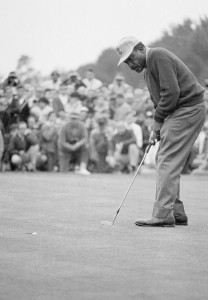African American Golfer Who Broke the PGA’s Color Barrier Dies
Thursday, February 5th, 2015February 5, 2015

Charlie Sifford, the African American who broke professional golf’s color barrier in 1961, playing a tournament in 1963. (Credit: AP Photo)
Charlie Sifford, the African American golfer who broke the color barrier in the Professional Golfers’ Association (PGA) died on February 3 at age 92. Sifford, who was denied the opportunity to play in high-level tournaments while was in his prime as an athlete, became the first black American to play in the PGA in 1961, when he was 38 years old. He was often referred to as “the Jackie Robinson of golf.”
Sifford caddied at a whites-only golf course in his home town of Charlotte, North Carolina, where he learned to play the game. When Sifford returned from his army service in Okinawa during World War II (1939-1945), he played on the golf tour for African Americans (the United Golf Association tour), but the prizes awarded for winning those tournaments were much lower than those awarded on the PGA tour.
In 1947, Sifford met Jackie Robinson, who in that year had become the first African American to play baseball in the modern major leagues. Robinson strongly encouraged Sifford to pursue his dream of becoming a professional golfer, cautioning him, however, that he would face anger and hostility both on and off the golf course. In fact, Sifford did face hateful speech and acts—he received death threats, was barred from staying at hotels, and was sometimes barred from eating in the restaurant of the golf club hosting the tournament he was playing in. Nevertheless, Sifford won several PGA tournaments and joined the Senior Tour (now the Champions Tour), for golfers age 50 and older, in 1980.
In 2004, Sifford was the first African American to be inducted into the World Golf Hall of Fame. In 2014, when U.S. President Barack Obama awarded Sifford with the Presidential Medal of Freedom, he stated “We give thanks to the trailblazers who built the arc of freedom towards justice.”
Other World Book articles:


